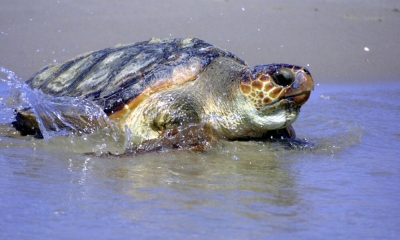
The loggerhead turtle is named for its large head, which supports powerful jaw muscles that enable them to feed on hard-shelled prey, such as whelks and conch. Loggerheads are the most abundant species of sea turtle that nests in the United States. Juvenile and adult loggerheads live in U.S. coastal waters, but many adults that nest on U.S. beaches migrate from neighboring nations like the Bahamas, Cuba, and Mexico.
Loggerhead populations in the United States declined due to bycatch in fishing gear such as trawls, gillnets, and longlines. The use of turtle excluder devices (TEDs) in shrimp trawls, gillnet bans, and other gear modification have reduced sea turtle bycatch in some fisheries, but bycatch in fishing gear remains the biggest threat facing loggerheads.
Loggerhead turtles have large heads with powerful jaws. The top shell (carapace) is slightly heart-shaped and reddish-brown in adults and sub-adults, while the bottom shell (plastron) is generally a pale yellowish color. The neck and flippers are usually dull brown to reddish brown on top and medium to pale yellow on the sides and bottom. Unlike freshwater turtles and tortoises, sea turtles cannot withdraw their head or flippers into their shells. Hatchlings are mostly dark brown, their flippers have white to white-gray margins, and the bottom shell is generally yellowish to tan.
Loggerhead turtles, like all sea turtles, are marine reptiles and must come to the surface to breathe air. Adult female sea turtles return to land to lay their eggs in the sand—they are remarkable navigators and usually return to a beach in the general area where they hatched decades earlier.
The life history of loggerhead turtles involves a series of stages of development from hatchling to adult. Hatchlings and juveniles spend the first 7 to 15 years of their lives in the open ocean. Then they migrate to nearshore coastal areas where they will forage and continue to grow for several more years. Adult loggerhead turtles migrate hundreds to thousands of kilometers from their foraging grounds to their nesting beaches.
Through satellite tracking, researchers have discovered that loggerheads in the Pacific undertake a trans-Pacific migration. Hatchlings from nesting beaches in Japan and Australia migrate across the Pacific to feed off the coast of Baja California, Mexico, Peru and Chile—nearly 8,000 miles! They spend many years (possibly up to 20 years) growing to maturity and then migrate back to the beaches where they hatched in the Western Pacific Ocean to mate and nest and live out the remainder of their lives.
Loggerheads are carnivores, only occasionally consuming plant material. During their open ocean phase, they feed on a wide variety of floating items. Unfortunately, trash and other debris discarded by humans also tends to accumulate in their habitat. Small fragments of plastic are often mistaken for food and eaten by turtles. Juveniles and adults in coastal waters eat mostly bottom dwelling invertebrates such as whelks, other mollusks, horseshoe crabs, and other crabs. Their powerful jaws are designed to crush their prey.
Credit : NOAA Fisheries
Picture Credit : Google




